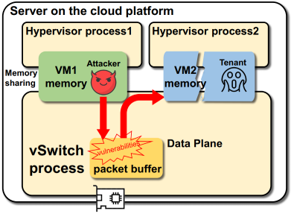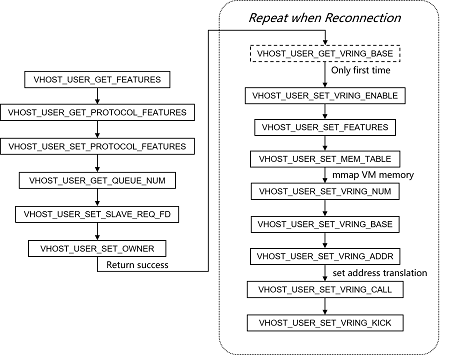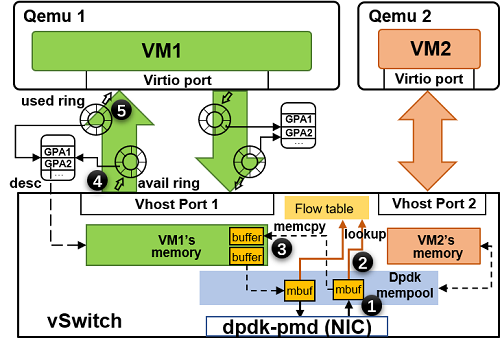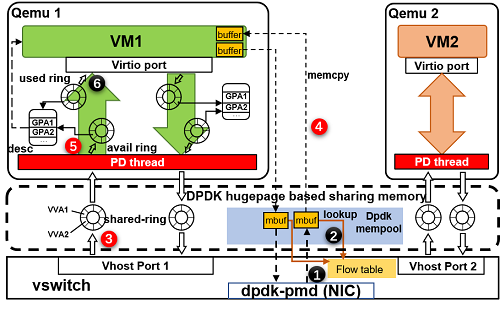Secure-vhost is an isolation enhanced vhost-user para-virtualized network I/O. It is built for the cloud platform, which runs VMs in high density. The VM memory isolation breakage in vhost-user may bring security risks for VMs on cloud. So in secure-vhost, we modify the memory sharing model to copy packets between VM and the host more securely.
A secure risk in tranditional vhost-user network I/O solution is that all VMs' whole memory is shared to DPDK accelarated vSwitch (e.g. OVS-DPDK) for memory copying between VM buffer and host buffer. A malicious tenant may take control the userspace vSwitch and "legally" access these VMs' memory. And even worse, this kind of illegal memory access is not easy to detected because it occurs totally in user space.
To make it clear, we use a example to describe this kind of illegal memory access as below:
In this figure, the malicious tenant firstly sends a well-designed packet to the user space vSwitch, then the vSwitch triggers a vulnerability to run the malicious code in the packet payload. By exploiting the feature that vSwitch can access all VMs' whole memory without restriction, the VM1's malicious code in packet payload can easily access VM2's whole memory. In this way, the key data of VM2 will be leaked and the stability is also threatened.
The vulnerability in open vSwitch can be: https://www.cvedetails.com/cve/CVE-2016-2074/. Though the vulnerability has been fixed, then what about other unknown vulnerabilities.
The community also has noticed this issue, they proposed a vIOMMU solution: http://www.linux-kvm.org/images/c/c5/03x07B-Peter_Xu_and_Wei_Xu-Vhost_with_Guest_vIOMMU.pdf. In this enhanced solution, each time when vSwitch needs to access VM's memory for packet copying, it should firstly send a socket based message to query QEMU process for address translation. The address translation done by the software vIOMMU can confirm the legitimacy of VM memory access. However, frequent communication will reduce performance to 20%, with severe packet loss (when using kernel driver inside the VM). So it is rarely used for practical environments.
To solve the security issue in vhost-user without dropping performance, we propose secure-vhost. In secure-vhost, we removed the insecure memory sharing, so VM memory do not need to be shared to any other processes. We transfered packet copying task from vSwitch to QEMU, so that vSwitch should securely share its host packet buffer to QEMU. As VM's main process, each QEMU process is responsible for the packet copying task of a particular VM. In our theory, QEMU is more trusty than vSwitch and it can access the VM memory inside it by default. So this kind of memory sharing and packet copying is more secure.
More security discussion can be seen in paper:
Ye Yang, Haiyang Jiang, Yongzheng Liang, Yulei Wu, Yilong Lv, Xing Li and Gaogang Xie, "Isolation Guarantee for Efficient Virtualized Network I/O on Cloud Platform" (accepted by HPCC-2020). See https://ieeexplore.ieee.org/document/9408002.
About ten years ago, a noval virtualized network I/O solution was proposed. That eventually develops the well-known IVSHMEM and NetVM. They all adopt the memory sharing mechanism that shares vSwitch's host packet buffer among all VMs, so that the packet copying is eliminated. All VMs can operate such a block of memory transparently. Once the packet is DMAed from hardware NIC to the host buffer, the vSwitch can notify the corresponding VM to access it (rather than copying it, just directly operating the memory in host buffer).
The weakness of NetVM and IVSHMEM is also obvious, VM can access the packets belonging to other VMs. So that solution was abandoned by the community.
For secure-vhost, we do not share host buffer directly to VM (that is insecure!). We share
host buffer from vSwitch to QEMU process (which is out of the access from tenants). QEMU is
part of the hypervisor, which is maintained by cloud service providers. It is trusty and with
higher privilege. At the same time, we can also use Intel PKEY and other means to allow
the shared memory can only be accessed by copy thread and it is invisible for other threads
(such as VCPU threads). This will further prevent some edge channel attacks.
As the price, one time of memory copying is inevitable in secure-vhost (while IVSHMEM and NetVM are zero-copy solutions).
The prototype system was implmented based on DPDK-17.11.2, OVS-2.9.2 and qemu-2.10.0-rc3.
This demo has been successfully built on:
OS: Ubuntu 16.04.1 (Kernel 4.15.0-142-generic)
CPU: Intel(R) Xeon(R) CPU E5-4603 v2 @ 2.20GHz
NIC: Intel 82599ES 10-Gigabit Dual Port NIC
But it has not been verified on other platforms yet.
To compile this demo, you should compile DPDK first:
cd dpdk-eal-master/
make install T=x86_64-native-linuxapp-gcc DESTDIR=install
Then compile SPDK:
cd ../spdk/
./configure --with-dpdk=../dpdk-eal-master/x86_64-native-linuxapp-gcc
make
The SPDK here is used to release the CPU from the heavy memory copying task, and to complete the memory-memory DMA operation via IOAT DMA engine. But as far as we know, the latest version of DPDK already supports this kind of DMA operation, and SPDK is no longer needed if you want to compile secure-vhost into higher version DPDK.
Compile and install OVS:
cd ../openvswitch-2.9.2/
./boot.sh
./configure --with-dpdk=../dpdk-eal-master/x86_64-native-linuxapp-gcc
make
make install
Compile and install QEMU:
cd ../qemu-2.10.0-rc3/
./compile.sh
You need to change the path in compile.sh according to your situation!
To use OVS, there is nothing different with the original version. We give
examples in start-vswitchd.sh and bridge.sh. You can use:
./start-vswitchd.sh
./bridge.sh -n <n(VM number)>
But for QEMU, we added DPDK EAL commands before QEMU commands. The two kinds of commands are separated by "--".
An example is as below:
./qemu-system-x86_64 -c 14 -w 0000:00:04.0 -- -machine accel=kvm -cpu host -smp...
Here, the -c 14 means the PD thread (packet copying thread, see "2.The memory
sharing and data path") will be bound to CPU core 14. Please note that the
scheduling strategy of PD threads is "SCHED_FIFO", so do not use this CPU core
to do anything else for it will always be occupied by the PD thread. We recommend
to bind PD thread to an isolated CPU core.
For specific commands for booting VM, you can learn from script setup.sh.
Please check the PATH inside all of the scrpts that you want to use and make sure they really meets your actual situation.
Secure-vhost is implemented based on vhost-user. The main difference between vhost-user and secure-vhost is the memory sharing and packet copying. So that means secure-vhost can achieve the same compatibility and scalability as vhost-user. And the transport from vhost-user to secure-vhost is not perceived by tenants.
In detail designs, there are three main points to illustrate:
1.The data path establishment
In vhost-user, before the data path established, there is an socket based channel to negotiate some configurations. The procedures are shown as the following figure:
The most important step is to process message VHOST_USER_SET_MEM_TABLE, which
is to call "mmap()" function to map VM's whole memory into vSwitch's memory
address.
In secure-vhost, we modified this message processing fuction. QEMU does not send
fd to vSwitch for "mmap()" VM memory. Instead, QEMU sends query message to vSwitch
for the name of mbuf_pool. Then in QEMU, it can easily operate packets in this
mbuf_pool transparently.
2.The memory sharing and data path
To make it clear the data path difference between the two solutions, we show both architectures in detail:
vhost-user
secure-vhost
Comparing these two figures, it is easy to find that each packet only needs one time of memory copying from host buffer to VM memory. The only change exists in shared memory and the packet copier.
In secure-vhost, to allow QEMU access vSwitch's host buffer, we compile QEMU into
DPDK EAL. So all QEMU processes and vSwitch process can operate the packets in mbuf_pool
concurrently.
3.The scheduling of PD threads
As each VM has a separated PD thread for copying packets. The CPU consumption will increase. To make it more CPU-friendly, we schedule multiple PD threads on the same CPU core.
But under Linux default "SCHED_OTHER" scheduling, one PD thread may be preempted when it is
in the critical zone. And that will cause serious dead lock (see "Known Issues" in http://doc.dpdk.org/guides/prog_guide/env_abstraction_layer.html).
So we set all PD threads under "SCHED_FIFO" and let each PD thread copy one batch of packets
before it calls "sched_yield()" to yield CPU core for others.
As secure-vhost is implemented on the old version of the open source software. Someone may want to use it in latest version. But unfortunately, this demo is deeply coupled in the software code. We can only give a guide about how to modify the original files to implement the main function of secure-vhost.
For DPDK:
dpdk-eal-master/lib/librte_vhost/vhost_user.c
dpdk-eal-master/lib/librte_vhost/virtio_net.c
In vhost_user.c, we modified the socket message processing functions.
In virtio_net.c, we removed the memory copying and added notification.
For QEMU:
vl.c
qemu-2.10.0-rc3/hw/virtio/vhost-user.c
qemu-2.10.0-rc3/hw/virtio/vhost.c
In vl.c, we added DPDK init function and DPDK command parse funtion.
In vhost.c, we added the PD thread creation and initialization.
In vhost-user.c, we modified the socket message processing functions, and we added
the main loop of PD thread and the packet copying function.



